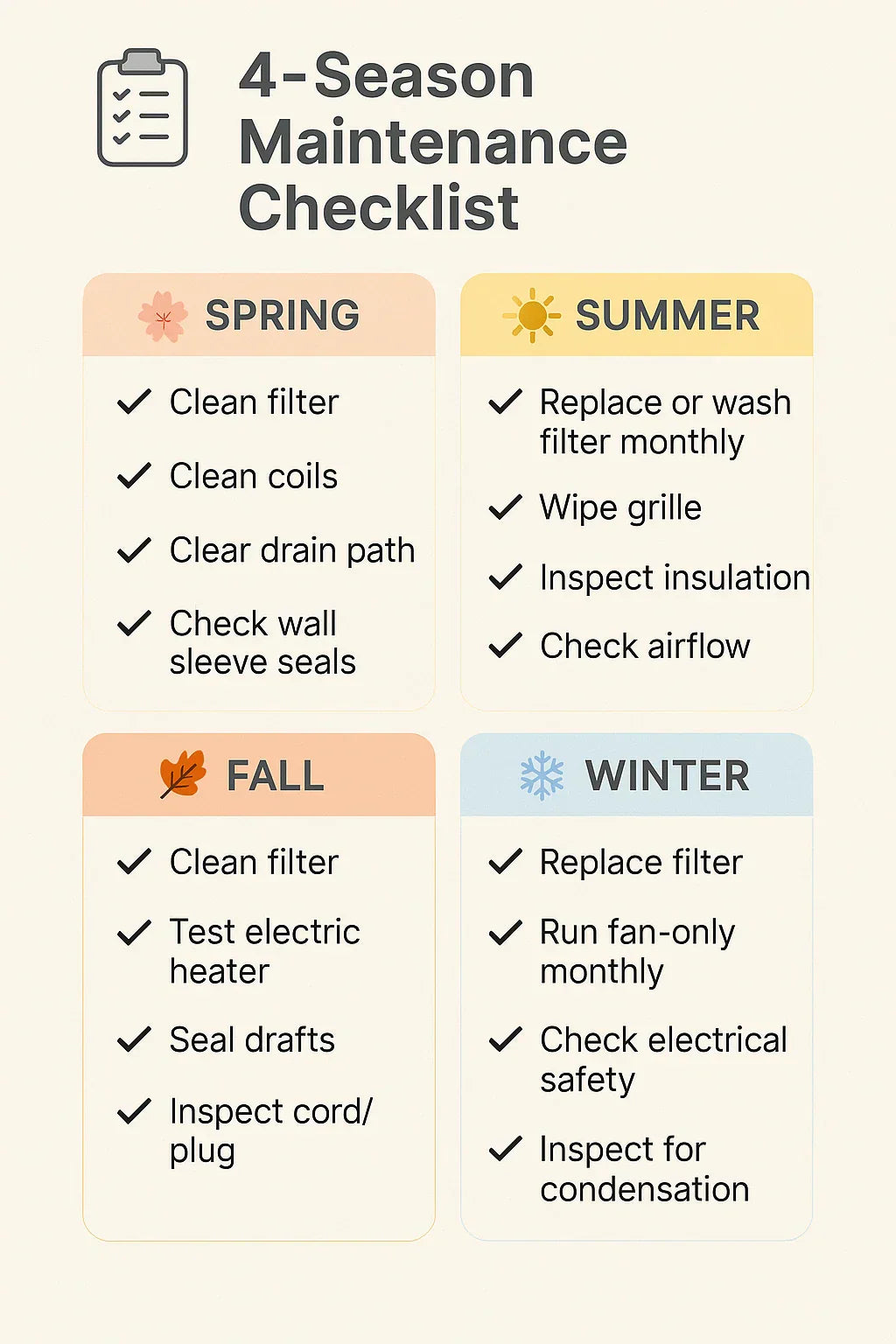🌬️ Why Maintenance Matters for Your Amana PTAC
When I first installed my Amana J-Series 17,000 BTU PTAC with 5 kW electric heat, I thought the hard part was over. Installation done, breaker flipped on, cool air flowing—check. But I quickly learned that a PTAC is not a “set it and forget it” appliance.
Just like a car needs oil changes, your PTAC needs routine care to keep it running quietly, efficiently, and reliably. Neglecting maintenance can mean:
-
Higher electricity bills
-
Reduced heating and cooling output
-
Musty odors or mold growth
-
Costly breakdowns
👉 According to the U.S. Department of Energy, simple maintenance like filter cleaning and coil care can reduce energy consumption by 5–15% . That’s real money saved.
🧼 Filter Cleaning & Replacement
Why Filters Matter
Your PTAC’s filter is its first line of defense. It traps dust, pet hair, and allergens before they clog the coils and airflow system. A clogged filter forces the unit to work harder, which means:
-
Lower efficiency
-
Louder operation
-
Shortened lifespan
How Often Should You Clean?
-
Every 30 days during heavy use (summer or winter).
-
Every 60 days during mild seasons.
If you have pets or live in a dusty area, stick to the 30-day rule.
How to Clean the Filter
-
Remove the front grille.
-
Slide out the filter gently.
-
Rinse under warm water or use a vacuum brush attachment.
-
Let it air dry completely before reinstalling.
Replacement Filters
Amana PTAC filters are washable, but over time they wear out. I replace mine once per year to keep airflow at peak performance.
💡 Samantha’s Tip: Keep a spare filter handy. Swap the dirty one immediately, then clean it at your convenience.
💧 Drain & Condensate Care
Why It’s Important
When your PTAC cools, it pulls humidity from the air, which condenses into water. That water needs a clear path to drain outside. If it doesn’t, you risk:
-
Mold growth
-
Rust inside the unit
-
Water leaks damaging your wall or floor
How to Check the Drain
-
Inspect the condensate pan inside the sleeve for standing water.
-
Look at the outdoor end of the sleeve—make sure leaves, dirt, or ice aren’t blocking the drain path.
-
If necessary, use a small brush or shop vacuum to clear debris.
Seasonal Timing
-
Spring: Before cooling season begins, ensure drains are clear.
-
Summer: Check monthly if you live in a humid area.
💡 Samantha’s Reminder: If you notice water dripping indoors, stop and address it immediately. Ignoring it leads to drywall damage.
❄️ Seasonal Deep Cleaning
Your PTAC works year-round, but its needs change with the seasons. Here’s my breakdown:
🌸 Spring – Fresh Start
-
Clean the coils: Use a fin comb and mild coil cleaner. Dirty coils reduce heat transfer, forcing the compressor to run longer.
-
Check seals: Inspect around the sleeve for air leaks.
☀️ Summer – Peak Cooling
-
Wipe the grille: Dust buildup on the front grille restricts airflow.
-
Check insulation strips: Make sure foam and seals are intact to keep humid air out.
-
Inspect filter monthly: This is when your PTAC works hardest.
🍂 Fall – Prep for Heating
-
Test electric heater strip: Don’t wait for the first cold night. Run it early to make sure it works.
-
Seal drafts: Replace worn insulation or caulk gaps.
-
Swap filters: Enter heating season fresh.
❄️ Winter – Lighter Use
-
Fan-only run: Once a month, run the fan to keep dust from settling deep inside.
-
Check cord and plug: Cold weather can stiffen cords; inspect for cracks.
-
Replace filter: Even in winter, airflow matters.
💡 Samantha’s Note: Doing these little seasonal steps prevents emergencies at the worst times—like a failed heater on the first freezing night.
🔌 Electrical & Safety Checks
While filters and drains are routine, I also add safety checks to my maintenance list.
-
Cord & Plug: Check for fraying, discoloration, or burns. Replace immediately if damaged.
-
Breaker & Voltage: Make sure your 230/208V circuit isn’t overloaded.
-
Smell & Sound: If you smell burning or hear crackling, shut it down and call a technician.
👉 The Occupational Safety and Health Administration (OSHA) warns that electrical issues should be taken seriously to prevent fire hazards .
📊 Efficiency & Comfort Hacks
Beyond maintenance, here are some small adjustments that make a big difference:
-
Clear airflow: Don’t block the PTAC with furniture, curtains, or décor.
-
Smart control: Use a compatible wall thermostat or smart plug to reduce energy waste.
-
Regular use: Run your PTAC periodically even off-season to keep internal parts moving.
💡 Samantha’s Hack: I set a reminder on my phone calendar every month labeled “PTAC filter & drain check.” Simple but effective.
🧾 Samantha’s Seasonal Checklist
Here’s the checklist I follow year-round:
🌸 Spring
✔️ Clean filter
✔️ Clean coils
✔️ Clear drain path
✔️ Check wall sleeve seals
☀️ Summer
✔️ Replace or wash filter monthly
✔️ Wipe grille
✔️ Inspect insulation
✔️ Check airflow
🍂 Fall
✔️ Clean filter
✔️ Test electric heater
✔️ Seal drafts
✔️ Inspect cord/plug
❄️ Winter
✔️ Replace filter
✔️ Run fan-only monthly
✔️ Check electrical safety
✔️ Inspect for condensation
🔗 Verified Resources
Here are the resources I used while building this checklist:
📝 Final Thoughts
Maintaining your Amana J-Series PTAC doesn’t have to be complicated. With just 10–15 minutes a month and a few seasonal deep dives, you can:
-
Lower your energy bills
-
Extend your unit’s lifespan
-
Keep your indoor air fresher
-
Avoid mid-season breakdowns
My mantra is simple: “Right-size your care, and your PTAC will take care of you.”
In the next topic we will know more about: Do Amana J-Series PTAC Units Qualify for Rebates or Tax Credits in 2025?







